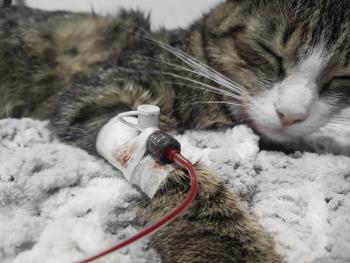
- dvm360 January 2021
- Volume 52
- Issue 1
Taking care of our veterinary students
“It is no use saying, ‘We are doing our best.’ You have got to succeed in doing what is necessary.” —Winston S. Churchill
Excessive student loan debt is a major issue in veterinary medicine. As general funding declined, veterinary colleges expanded enrollment—mostly with out-of-state students—and increased tuition and fees to compensate. Tuition began rising above inflation during the 1990s1; currently about 85% of veterinary students have educational debt.
We often hear complaints that today’s veterinary students are more demanding and less tractable than their predecessors. There may be some truth in this assertion but, if so, it is a sign of the times rather than a deficiency of character. Veterinary education is evidently much more crowded, more exacting, more expensive, and more stressful than at any previous time. Being a successful veterinary student is far from easy.
Nationally, the 2019 median in-state annual veterinary school tuition was approximately $32,000, while out-of-state students paid $52,000.2 The ultimate problem is not just debt. It is the debt-to-income ratio. The average 2019 starting salary for new graduates was about $80,000, and their median debt was $174,000,3 with some reaching staggering debt loads of $300,000 or more. Inevitably, nonresidents (on average) accumulate more debt than their in-state counterparts. Also, the high price of education disproportionately discourages underrepresented and financially disadvantaged students from applying to veterinary school, thus threatening
Presently, the mean debt-to-income ratio for new graduates is more than 2:1. To achieve a more manageable 1:1 ratio, students should not borrow more than their anticipated salary upon graduation. This, of course, is easier said than done. It is not that students don’t recognize the seriousness of excessive debt, but they have no recourse to the college administration for tuition abatement. Also, a unique feature of veterinary medicine is its dependence on the human-animal bond, and many students disregard the financial dangers because the reward of becoming a veterinarian is so great.4 Borrowing is facilitated by easy access to government-backed loans; and too many students are lured into debt levels they simply can’t handle. Extreme debt can affect students’ mental health,5 impairing their academic performance and causing stress in their personal and professional lives. To lessen the financial burden, some new graduates give up their preferred career track and choose a higher-paying specialty. Ultimately, this will unbalance the species-discipline structure of the veterinary workforce and limit the profession’s ability to meet society’s needs.
Many veterinary hospitals provide fringe benefits in addition to a base salary, including sign-on premiums, performance bonuses, dues and insurance payments, and loan repayment assistance. These financial perks are becoming widely available, especially in companion animal corporate practice. Even so, student debt is still increasing faster than income; consequently, the debt-to-income ratio continues to grow. Yet despite the dangers, the number of applicants seeking veterinary education continues to expand and colleges persist in charging exorbitant tuition while fully aware that they are jeopardizing the future finances of their students.
Clearly, the current tuition cash-flow is not sustainable. Sooner or later veterinary education will become so prohibitively expensive that the pool of qualified applicants will dry up along with their accompanying tuition dollars. This would create a financial crisis that certainly would catch everyone’s attention. But passively waiting for a dire emergency to mobilize necessary action makes no sense.
Fixing student debt begins and ends with the veterinary colleges. They have an ethical duty of care to students in their charge. It will be an uphill battle taking multiple years and cannot be solved with a few easy changes to the status quo, such as business/finance literacy training, support for personal wellbeing, and more scholarships and financial aid. Unquestionably, these are valuable initiatives that must be maintained, but they fail to address the root cause of the problem. To provide significant tuition-debt relief, colleges will need to be more efficient with all their resources—taxpayer dollars and private philanthropy—to educate veterinary students at a lower cost. Savings created by increasing efficiency could then be used to lower tuition and support the students’ financial health and career success.
A big step toward reducing student expenses would be to modify the DVM degree program so that preveterinary requirements are completed in 2 years.6,7 Students would save on educational and living costs, and start gainful employment 2 years sooner. The American Veterinary Medical Association Council on Education has fully accredited a number of prestigious 5- and 6-year veterinary degrees internationally, and some US veterinary colleges have been accepting students after 2 years of undergraduate education for decades. There is no technical reason why this arrangement could not be adopted universally.7,8
Leading transformative change is difficult and contentious, requiring a fresh mindset and determined, purposeful action. The colleges are unlikely to solve the tuition-debt problem with the same thinking they used when they created it.
I imagine not everyone will agree with all that I have said here. Nevertheless, student success is at the very foundation of every veterinary college’s mission, and students own the profession’s future. It is hard to imagine anything more important than making veterinary education affordable and accessible to aspiring students across the socio-economic spectrum, if our veterinary colleges and their graduates are to make an optimal contribution to society in the future.
Peter Eyre, DVM&S, BVMS, BSc, PhD, is professor and dean emeritus at Virginia-Maryland College of Veterinary in Blacksburg, Virginia.
References
- Larkin M. AVMA report gives specifics on student debt quandary. J Am Vet Med Assoc 2015;247:1345-1347.
- Mattson K. The veterinary student population by the numbers. American Veterinary Medical Association. April 24, 2019. Accessed November 10, 2020.
https://www.avma.org/javma-news/2019-05-15/veterinary-student-population-numbers - Larkin M. Good news, bad news for educational debt, starting salaries. American Veterinary Medical Association. November 25, 2019. Accessed November 10, 2020.
https://www.avma.org/javma-news/2019-12-15/good-news-bad-news-educational-debt-starting-salaries - Larkin M. Worth the price of admission? American Veterinary Medical Association.
December 1, 2015. Accessed November 10, 2020.https://www.avma.org/javma-news/2015-12-15/worth-price-admission - Merck Animal Health Veterinary Wellbeing Study. Merck Animal Health. February 2018. Accessed November 10, 2020.
https://www.merck-animal-health-usa.com/pdfs/vca/MAH-Well-Being-Study.pdf Larkin M. Veterinary colleges look within for debt reduction strategies. American Veterinary Medical Association. June 1, 2016. Accessed November 10, 2020.https://www.avma.org/javma-news/2016-06-15/veterinary-colleges-look-within-debt-reduction-strategies - Eyre P. The problem of student debt [letter]. J Am Vet Med Assoc. 2020;256:168.
- Eyre P. Time for action on student debt. dvm360.com. December 31 2019. Accessed November 20, 2020.
https://www.dvm360.com/view/commentary-time-action-student-debt
Articles in this issue
almost 5 years ago
Delving into DEA regulations for veterinary practicesalmost 5 years ago
Think like a dermatologist: untangling itchalmost 5 years ago
Your one-stop shop for all things veterinaryalmost 5 years ago
Snap judgments: Aggression problem or medical condition?almost 5 years ago
What’s new in veterinary cancer?about 5 years ago
Tools of the tradeabout 5 years ago
Finessing the feline physicalabout 5 years ago
KC Animal Corridor announces 2020 Iron Paw Award recipientabout 5 years ago
Have fun, will buildabout 5 years ago
The Dilemma: temper, temper!Newsletter
From exam room tips to practice management insights, get trusted veterinary news delivered straight to your inbox—subscribe to dvm360.




